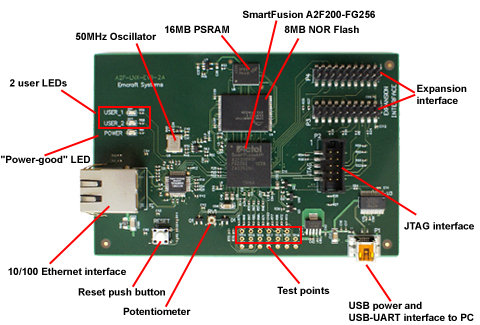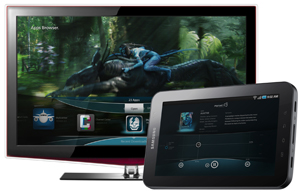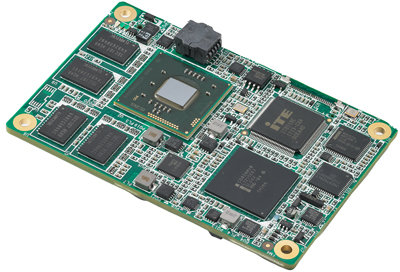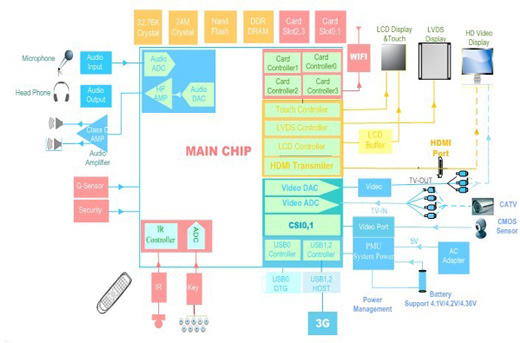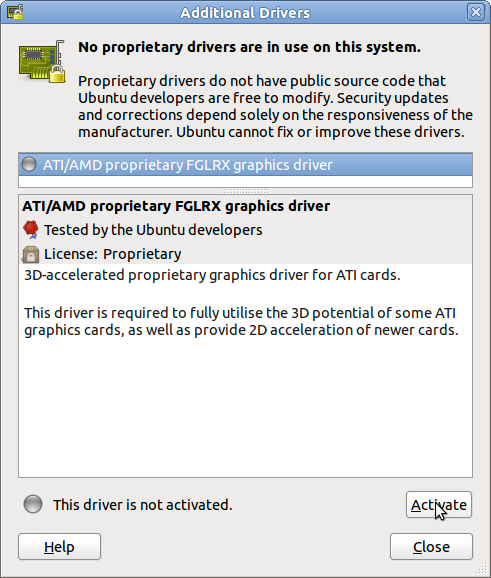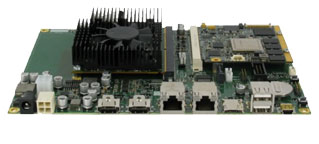There are plenty of low cost Linux development boards based on Cortex A8 or A9 such as the Beaglebone, as well as some devkits based on ARM7 and ARM9 such as SAM9 development kits , but if your application is cost and/or energy sensitive you can also switch to micro-controllers using Cortex M3 or M4 based development boards such as Emcraft SmartFusion devkits. You can run a functional uCLinux system with 1MB of RAM and 1MB of flash including the TCP/IP stack. You need to use uClinux and not directly Linux, because the Cortex M3 doess not have a Memory Management Unit (MMU) and only a Memory Protection Unit (MPU). This can bring some interesting software development challenges such as (apparently random) kernel panics, the lack of fork, memory fragmentation and more. You can check out http://kernel.org/pub/linux/libs/uclibc/Glibc_vs_uClibc_Differences.txt for the main differences between uClibc and Glibc. The instructions to patch and […]
Myriad Alien Vue Brings Android to Your TV
Myriad Group, a company based in Switzerland, brings Android (and a Google TV alternative) to non-Android platforms through its Alien Davlik technology, called Myriad Alien Vue. Alien Vue is a solution that enables TV service providers to add apps to their existing managed service offerings, in order to respond to over-the-top (OTT) content distribution channels from Apple, Google and others. It is compatible with apps developed using HTML5 and most Google TV apps such as YouTube, Netflix and Twitter apps. The release includes an app store developed in conjunction with AppCarousel that can be fully be customized / branded by service providers. Myriad Alien Vue also supports additional plug-in components like Myriad Connect & Share, providing multi-screen functionality for personal and premium content. Alien Vue allows to leverage existing TV and set-top box equipment and works with mobile phones and tablets to give users control over their TV experience. Alien […]
Advantech Announces COMs, SBCs, Motherboards and Embedded PCs based on Intel Atom N2000 and D2000 Series
Advantech has updated its product range by adding Computer On Modules (COMs). single board computers (SBCs), industrial motherboards and embedded box PCs based on the latest Intel Atom N2000 and D2000 Series processors to its offerings. These low-power embedded platforms provide energy-efficient solutions, and serve a wide range of applications targeted at handheld devices, POS, kiosks, digital signage, medicine, and factory automation. Computer On Modules: SOM-7565 and SOM6765 The Advantech COM-Express Mini SOM-7565, with a mere 84 x 55 mm board size, benefits the low power consuming handheld devices market. SOM-7565 Key Features: PICMG COM R2.0 compliant module for Intel Atom processors N2600 Intel gfx support for DirectX 9 and Open GL 3.0 Supports 18-bit LVDS, eDP/HDMI/DVI/DisplayPort Onboard 2 GB DDR3 800 memory and 4 GB SSD Supports 3 PCIe x1, LPC, SMBus, I2C Bus, SATAII, 8 USB2.0, and GbE Supports Advantech iManager 2.0 and software APIs The COM-Express Compact […]
AllWinner A10/A1X Processor Resources, Development Board and SDK
AllWinner A10 (part of A1X series) is an ARM Cortex A8 SoC targetting multimedia products such as tablets, HD STB or digital signage. It is currently found in some low cost Android tablets such as Momo9C and will be used in Rhombus Tech’s Raspberry Pi alternative. The processor features an ARM Cortex A8 clocked at 1.5 Ghz with a Mali-400 GPU. It can support 1080p encoding/decoding, provides HDMI, Component, Composite, VGA and LVDS video outputs, USB2.0 ports, a SATA 2.0 port and more… Here are the key features of the Allwinner A10: VPU (Video Processing Unit) HD Video Decoding (Super HD 2160P/3D Film) Support all popular video formats, including VP8, AVS, H. 264 AVC, VC-1, MPEG-1/2/4, … HD Video Encoding (H.264 High Profile) Support encoding in H.264 format DPU (Display Processing Unit) MULTI-CHANNEL HD displays Built-in HDMI YPbPr, CVBS, VGA LCD interfaces: CPU, RGB, LVDS up to Full HD Memory […]
Android Drivers Will Be Included in Linux Kernel 3.3
The Android drivers were no longer accepted in the mainline Linux kernel, starting with Linux kernel 2.6.33, as announced by Greg Kroah-Hartman back in spring 2010. But this is about to change, as it appears that Greg Kroah-Hartman will include the Android drivers into his development branch for the upcoming Linux kernel 3.3, making it boot on Android devices without being patched. The Linux Foundation’s Consumer Electronics workgroup, along with a group at Linaro and various individual developers, is working with Kroah-Hartmann on this project. Tim Bird, chair of the Architecture Group, announced the Android Mainlining Project on the 20th of December with the goal of coordinating work on integrating the Android features. Further information on this project is available on the wiki and developers can also sign up for the project’s mailing list to join the 15 other persons involved in the project. Jean-Luc Aufranc (CNXSoft)Jean-Luc started CNX Software […]
Linaro 11.12 Release with Kernel 3.1.5
Linaro has just released version 11.12 based on Linux Kernel 3.1.5 and further support for Android 4.0 including graphics hardware acceleration on Snowball and Origen development boards. Here are the highlights of the release: Android Linaro ICS is built with the Linaro toolchain. Linaro ICS is running on all supported boards. DS-5 with Gator is supported in all Linaro Andoid ICS builds. The latest version of libpng (1.5.7) has been integrated in Linaro ICS. An AOSP master build is now available from linaro. ARM® Mali™ Hardware Accelerated Graphics is supported on Origen and Snowball. libjpeg-turbo has been integrated into all Andoid ICS builds. Developer Platform The linux-linaro and lt-panda kernel packages are now automatically generated by the CI build scripts DS-5 with Gator is supported in all Ubuntu LEB builds. XBMC packages, with Gstreamer and OpenGLES support, are now available at the Ubuntu Overlay (supporting only Panda initially) U-Boot-Linaro is […]
Dual Monitor Setup with ATI Graphics Cards in Ubuntu
I’ve recently bought an ATI Radeon HD5450 in order to be able to use multiple displays in Windows XP and Ubuntu 11.04. I’ll explain how to install and configure the ATI drivers in order to use multiple displays and extend the desktop on two monitors. The first thing to do is to install the proprietary ATI drivers and Catalyst Control Center. Click on the icon at the top right of the screen and select “System Settings” in the drop down menu. Then click on “Additional Drivers”, Ubuntu should detect your ATI graphics card automatically and show the following: Click on “Activate” to download and install ATI/AMD proprietary FGLRX graphics driver and Catalyst Control Center (CCC). Alternatively, you could also download the latest linux ATI driver (version 11.12) on ATI website and run ./ati-driver-installer-11-12-x86.x86_64.run After installation, you may have to restart you computer. Once the drivers are installed, if you use […]
Nvidia Announces CARMA Tegra 3 CUDA Development Kit
Nvidia has just unveiled its Tegra 3 development kit, the Nvidia CARMA. The development kit codename has been crowdsourced as Nvidia asked its followers to propose a name and vote for the best name. This development kit particularly targets CUDA, Nvidia parallel computing platform and programming model that enables dramatic increases in computing performance by harnessing the power of the graphics processing unit (GPU). The CARMA hardware has been designed by Seco and features an NVIDIA Tegra 3 ARM Cortex A9 Quad-Core CPU and NVIDIA CUDA GPU QuatroTM. Here are the technical specs for the development kit: CPU NVIDIA Tegra 3 Quad-Core ARM A9 GPU NVIDIA QuadroTM 1000M with 96 CUDA Cores Memory • CPU Memory: 2 GB • GPU Memory: 2 GB Peak Performance 270 Single Precision GFlops CPU – GPU Interface PCIe x4 Gen1 link Network 1x Gigabit Ethernet Storage 1x SATA Connector USB 3x USB 2.0 Display […]


